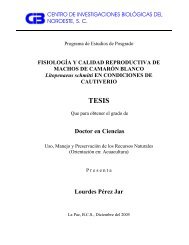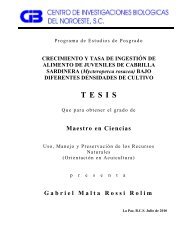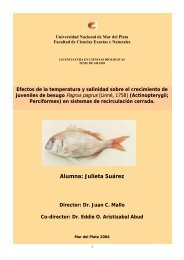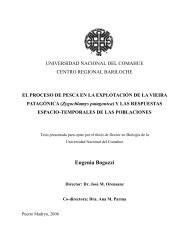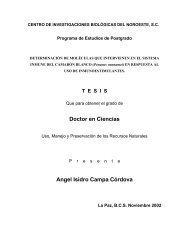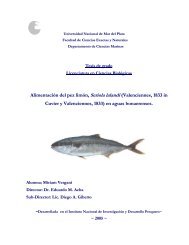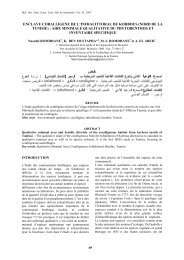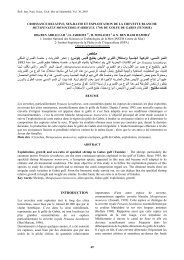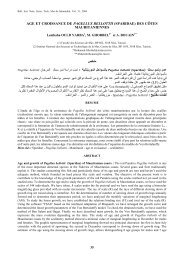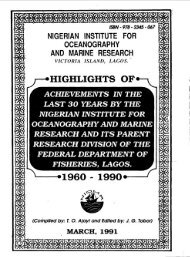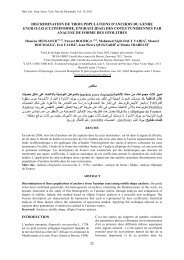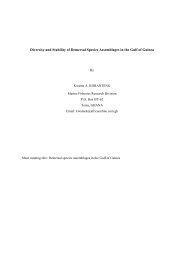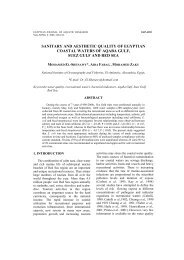Coastal vulnerability, resilience and adaptation to ... - OceanDocs
Coastal vulnerability, resilience and adaptation to ... - OceanDocs
Coastal vulnerability, resilience and adaptation to ... - OceanDocs
You also want an ePaper? Increase the reach of your titles
YUMPU automatically turns print PDFs into web optimized ePapers that Google loves.
tations <strong>to</strong> sea-level rise (for a more elaborate discussion see Klein <strong>and</strong> Nicholls, 1999). It was<br />
used as the basis of assessments in at least 46 countries. The assessments aimed at identifying<br />
populations <strong>and</strong> resources at risk <strong>and</strong> the costs <strong>and</strong> feasibility of possible responses <strong>to</strong> adverse<br />
impacts. Quantitative results were produced in 22 country case studies (shown in Table<br />
4) <strong>and</strong> eight subnational studies (Nicholls, 1995b).<br />
It is important that the quantitative results in Table 4 are interpreted as being indicative<br />
only. Studies using the Common Methodology were meant <strong>to</strong> serve as prepara<strong>to</strong>ry assessments,<br />
identifying priority regions <strong>and</strong> priority sec<strong>to</strong>rs <strong>and</strong> providing an initial screening of<br />
possible measures. Scientific uncertainties are compounded by uncertainties surrounding future<br />
socio-economic developments <strong>and</strong> by the fact that the damage cost estimates are sensitive<br />
<strong>to</strong> the use of discount rates. In addition, the impacts shown in Table 4 have been assessed<br />
assuming a one-metre rise in sea level by 2100, whereas the latest scientific information,<br />
as presented in Section 3.1, suggests a lower global mean sea-level rise. On the other<br />
h<strong>and</strong>, one can argue that the results may well represent underestimates, because impacts on<br />
non-market values have not been assessed <strong>and</strong> because the studies assume sea-level rise <strong>to</strong><br />
be a gradual process. As shown by West <strong>and</strong> Dowlatabadi (1999) <strong>and</strong> West et al. (2001), superimposing<br />
current s<strong>to</strong>rm-surge variability on a gradual rise in sea level can lead <strong>to</strong> estimates<br />
of damage costs that are an order of magnitude different from those based only on<br />
gradual changes, where perfect foresight is assumed (cf. Yohe et al., 1996; Yohe <strong>and</strong> Neumann,<br />
1997).<br />
As noted by Klein <strong>and</strong> Nicholls (1999), many studies that used the Common Methodology<br />
faced a lack of the accurate <strong>and</strong> complete data necessary for impact <strong>and</strong> <strong>adaptation</strong> assessment.<br />
This has limited its applicability, which has led <strong>to</strong> the development of alternative assessment<br />
methodologies (e.g., Kay <strong>and</strong> Hay, 1993; Gornitz et al., 1994). Nonetheless, no<br />
other methodology has been applied as widely <strong>and</strong> evaluated as thoroughly as the Common<br />
Methodology (e.g., Kay et al., 1996). Thus, it has contributed <strong>to</strong> underst<strong>and</strong>ing the consequences<br />
of sea-level rise <strong>and</strong> encouraged long-term thinking about coastal zones. It also became<br />
a model for assessing impacts <strong>and</strong> <strong>adaptation</strong> in non-coastal systems.<br />
In 1994, the IPCC published its Technical Guidelines for Assessing Climate Change Impacts<br />
<strong>and</strong> Adaptations (Carter et al., 1994), which provide generic guidance <strong>to</strong> countries that<br />
wish <strong>to</strong> assess their <strong>vulnerability</strong> <strong>to</strong> climate change. For a range of socio-economic <strong>and</strong> physiographic<br />
systems, the United Nations Environment Programme (UNEP) H<strong>and</strong>book on Methods<br />
for Climate Change Impact Assessments <strong>and</strong> Adaptation Strategies (Feenstra et al., 1998) then<br />
offers a detailed elaboration of the IPCC Technical Guidelines, including for coastal zones<br />
(Klein <strong>and</strong> Nicholls, 1998). The similarities <strong>and</strong> differences between the IPCC Common Methodology<br />
<strong>and</strong> the IPCC Technical Guidelines are discussed in Klein <strong>and</strong> Nicholls (1999). Klein et<br />
al. (1999) evaluate the guidance on <strong>adaptation</strong> assessment provided by the IPCC Technical<br />
Guidelines.<br />
Adaptation can play an important part in reducing the potential impacts of climate<br />
change in coastal zones. In both the IPCC Common Methodology <strong>and</strong> the IPCC Technical<br />
Guidelines, the guidance provided for <strong>adaptation</strong> assessment is limited. Rather than evaluating<br />
a range of options using some formal decision-making framework (e.g., cost-benefit or<br />
multi-criteria analysis), studies tended <strong>to</strong> consider only a protection versus a do-nothing scenario.<br />
However, there are many different ways <strong>and</strong> options <strong>to</strong> respond <strong>to</strong> the impacts of sealevel<br />
rise (see Section 4.3).<br />
In fact, many of the early studies used a so-called “dumb farmer” scenario 2 : they assumed<br />
that present-day behaviour <strong>and</strong> activities would continue unchanged in the future, irrespective<br />
of how they might be affected by climate change. By ignoring any <strong>adaptation</strong>,<br />
these studies did not distinguish between potential <strong>and</strong> residual impacts <strong>and</strong> thus their damage-cost<br />
values represent serious overestimates. On the other h<strong>and</strong>, the studies, which are<br />
not unique <strong>to</strong> agriculture, served <strong>to</strong> generate awareness of the potential magnitude of impacts<br />
<strong>and</strong> the need for anticipa<strong>to</strong>ry <strong>adaptation</strong>.<br />
2<br />
The dumb farmer is a metaphor for any impacted economic agent that does not anticipate climate change or<br />
act upon its manifestation. Instead, it continues <strong>to</strong> act as if nothing has changed. By not responding <strong>to</strong> changing<br />
circumstances, the agent reduces its profitability or fails <strong>to</strong> take advantage of emerging opportunities. It thus<br />
incurs larger damages than would have been the case had some <strong>adaptation</strong> taken place. The clairvoyant<br />
farmer, on the other h<strong>and</strong>, has perfect knowledge <strong>and</strong> foresight <strong>and</strong> is able <strong>to</strong> minimise damages or maximise<br />
benefits. As always, reality will be somewhere in between.<br />
13



